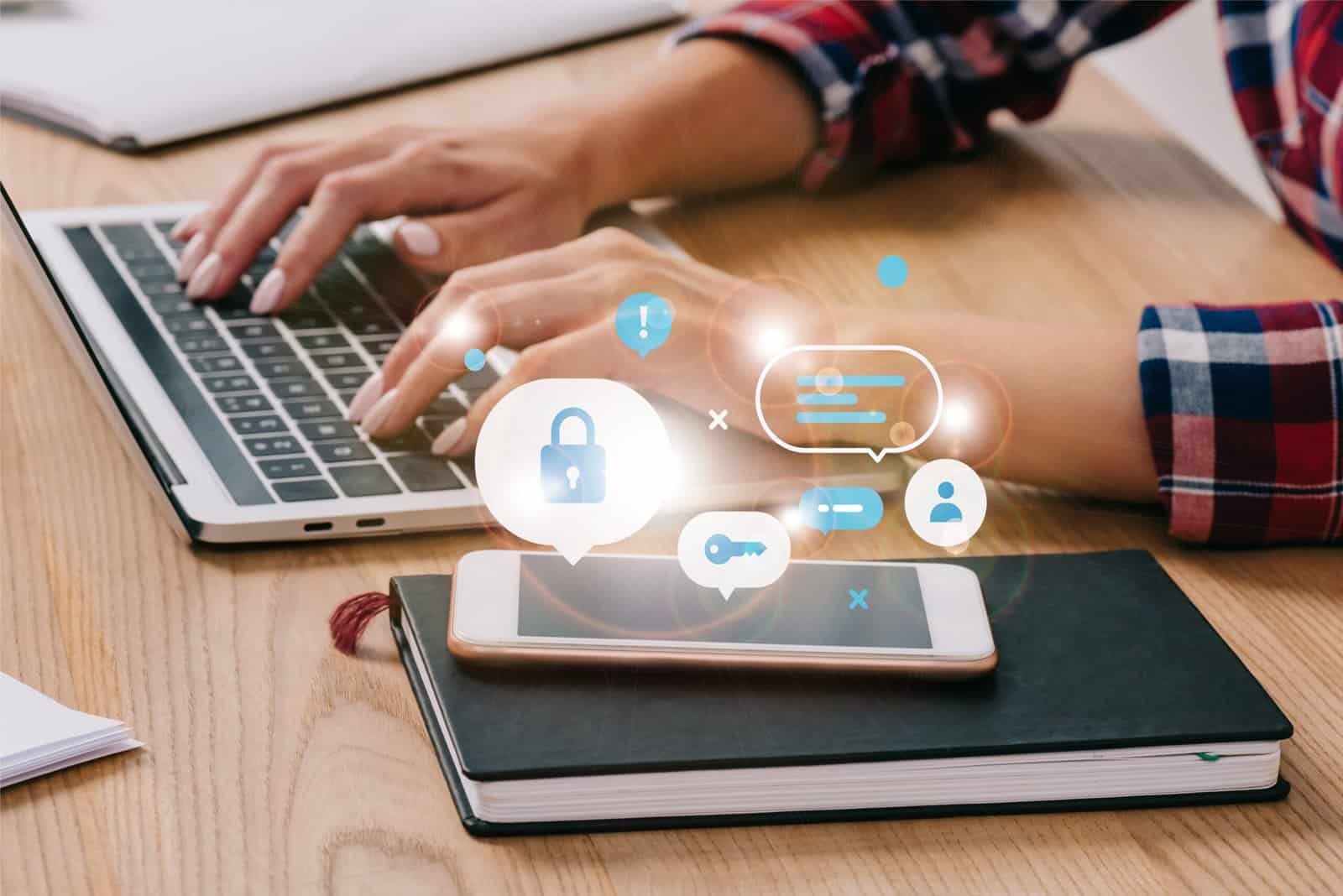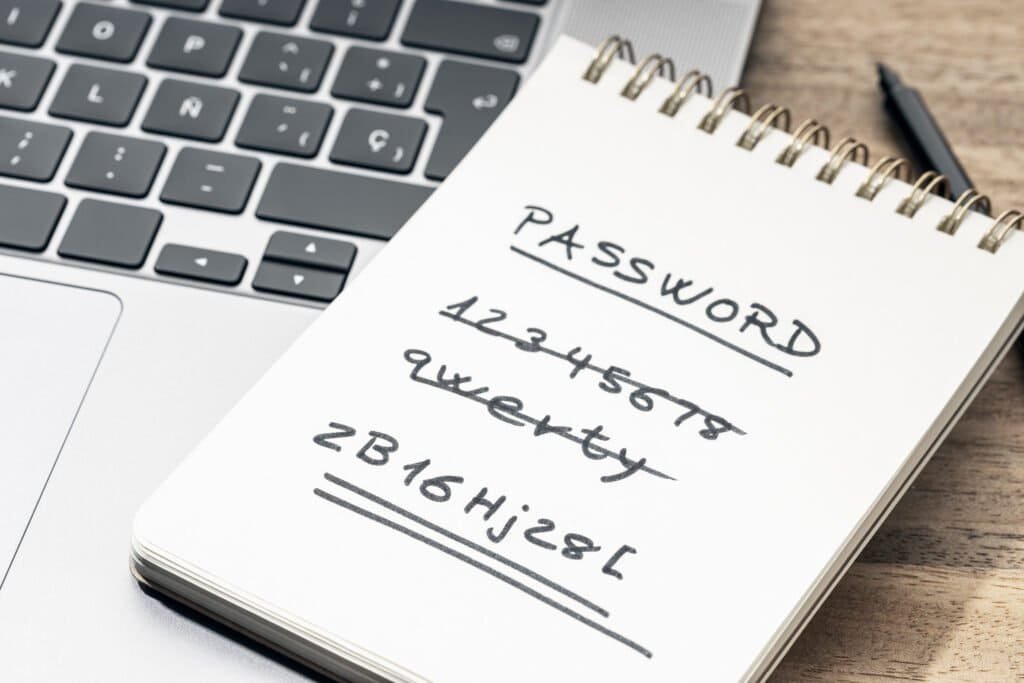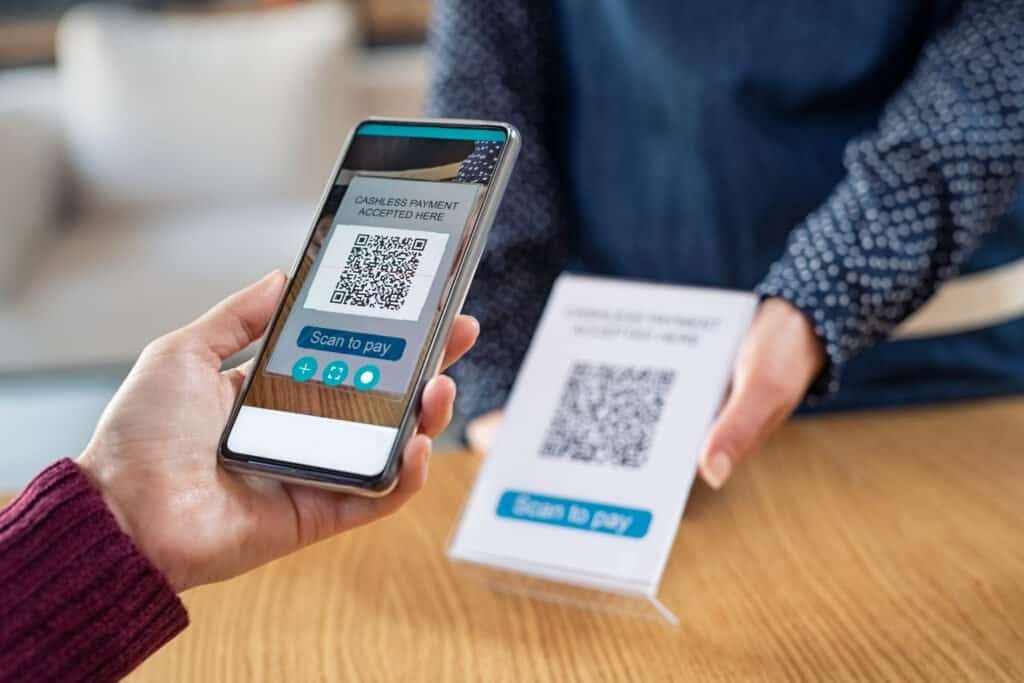Top strategies on how to protect against hackers: Your personal cyber security guide

We may earn a small fee from the companies mentioned in this post.
Wondering how to protect against hackers? In an online world rife with cyber crime threats, you need effective defences. This article provides straightforward strategies to prevent and report cybercrime and criminals and fortify your digital security—no unnecessary complexity, just actionable steps to shield your personal and financial information from cybercriminals.
Key takeaways – How to protect against hackers
Strengthening your password protocols, such as using complex and unique passwords, avoiding password reuse, and enabling two-factor authentication, is crucial for enhancing personal cybersecurity.
Implementing multi-layered security software, like anti-virus and anti-spyware, along with regularly updating software, provides comprehensive protection against cyber threats.
Educating yourself on cybersecurity threats and practices, including safe networking, vigilance against phishing attempts, and proactive data protection measures like regular backups and encryption, is essential in safeguarding against cyber attacks.
Strengthening your passwords

As we start your journey to discover how to protect yourself from hackers, we begin with passwords. Think of your password as the first line of defense against cyber attacks. It’s like a digital lock to your personal and financial information. However, are your locks strong enough to keep the cybercriminals at bay? We’ll examine some strategies to enhance your strong password protocols.
Crafting complex passwords
To create a complex password, aim for a mix of uppercase and lowercase letters, numbers, and special characters, making it at least 12-16 characters long. Avoid using easily guessable information, such as birthdays, names, or common words.
Instead, consider using a passphrase—a sequence of words or a sentence that you can remember but is hard for others to guess. For added security, incorporate randomness and unpredictability into your passphrase, perhaps by replacing letters with numbers or symbols (e.g., “E” becomes “3” or “S” becomes “$”).
Remember, the more complex and unique your password is, the harder it is for hackers to crack it through brute force or guessing attacks. Utilising a password manager can also help manage and store your complex passwords securely, ensuring you don’t have to compromise on password strength for the sake of memorability.
The role of password managers
Remembering a unique, complex password for each of your accounts can be a daunting task. Enter password managers. These handy tools help generate and store strong, unique passwords for each account, acting as a secure vault for your passwords. They also encrypt your data, adding an extra layer of security.

Hence, when you’re having trouble recalling your passwords, a password manager might come in handy.
Avoiding reused passwords
Most of us are gulity of using a single password across multiple accounts. It’s easy to remember, right? But here’s the catch. If a hacker gets hold of that password, they can gain access to all those other accounts too. It’s like giving a thief a master key to all your locks.
The golden rule of online security? Never use the same password across many different sites or accounts.
Two-Factor security (2FA)
Imagine a vault with two separate locks. To open it, you need two unique keys. This is exactly what two-factor authentication (2FA) does for your online accounts. It adds an extra layer of security by requiring a secondary verification method, such as a text message or fingerprint. It’s like having a security guard in addition to your locks.
Multi-Factor security (MFA)
Multi-factor authentication extends the concept of 2FA by requiring two or more verification factors, which includes something you know (password), something you have (a security token or smartphone app), and something you are (biometric verification). MFA provides an even higher level of security by adding more layers that a cyber attacker must circumvent to access data.
Benefits of 2FA and MFA
- Enhanced security: By requiring multiple forms of verification, these methods significantly reduce the risk of unauthorised access. Even if one factor (like a password) is compromised, unauthorised users still need to bypass the additional security layers.
- Reduced fraud and identity theft: 2FA and MFA make it much harder for attackers to impersonate users, thereby reducing the chances of identity theft and fraud.
- Compliance: Many industries now require 2FA or MFA to comply with regulatory standards, helping protect sensitive data like financial records and personal information.
While 2FA and MFA significantly enhance security, they are not foolproof. You must manage additional steps during the login process, which can sometimes lead to resistance or frustration. Moreover, factors like biometrics and mobile devices introduce their own security and privacy concerns that need to be addressed.
Passwordless authentication
In a world where passwords are becoming increasingly complex, passwordless authentication offers a refreshing alternative. This method uses unique means, such as a phone number or biometric data, to verify your identity, eliminating the need for a password.
Thus it team that, if remembering intricate passwords is burdensome, exploring passwordless authentication options for other machines could be beneficial.
Implementing multi-layered security software

Consider your computer as a castle. Your passwords are the guards at the gates, but what about the walls and towers? These are represented by your security software and operating system. A robust, multi-layered security software ensures comprehensive protection against various cyber threats. It’s like having an army protecting your castle from all sides.
We’ll scrutinize different types of security software that are worth your consideration.
Introduction to Anti-virus software
An essential soldier in your cybersecurity army is internet security software, such as antivirus software. It’s like a watchdog, constantly scanning your computer system for malicious software and barking (alerting) when it finds something suspicious. It helps protect your operating system against:
Viruses
Malware
Ransomware
Spyware
Adware
Phishing attacks
Identity theft
Therefore, it’s important to have reliable anti-virus software in your arsenal.
Ransomware
Ransomware is a type of malicious software designed to block access to a computer system or files until a sum of money, or ransom, is paid. This cyber threat encrypts the victim’s files, making them inaccessible, and demands payment for the decryption key.
Ransomware attacks can target individuals, businesses, and even government agencies, causing significant financial and data losses. The mode of infection often involves phishing emails, malicious advertisements, or exploiting security vulnerabilities.
Beyond the immediate impact of data loss and financial extortion, ransomware attacks can lead to significant downtime, reputational damage, and the potential loss of sensitive or proprietary information.
The best defence against ransomware includes maintaining up-to-date backups, implementing robust security practices, and educating users about the risks of phishing and other forms of social engineering.
Real-time protection with Anti-virus software
Real-time protection is like having a guard on duty 24/7. It constantly monitors your mobile device for any suspicious activity, ready to take immediate action as soon as a threat is detected. This feature ensures you’re protected round the clock, even when you’re not actively using your device.

The importance of regular software updates
Keeping your software updated is like fortifying your castle’s walls. Each update patches potential vulnerabilities in your software, making it harder for hackers to breach your defenses and steal data from. Thus, regularly updating your software can help you stay ahead of cybercriminals.
Layered defence with Anti-spyware
Antispyware provides an additional layer of defense by protecting against spyware threats. It’s like having an undercover agent in your system, constantly on the lookout for spies (spyware) trying to steal your information. With antispyware, you can rest assured that your personal information is well-protected.
Securing your online presence

In this digital age, we all have an online presence. It’s like having a digital home. And just like our physical homes, our digital homes need to be secured too. This involves managing social network media settings, online credentials, devices, and financial transactions.
We’ll investigate how best to secure our digital homes.
Social media platforms are like public squares. While they are great for connecting with others, they also expose you to potential risks. Cybercriminals can exploit the information you share on your social media accounts, so it’s essential to be cautious about what you post and who can see it.
Fine-tuning your social media settings is like putting curtains on your windows. It allows you to to regain access and control over who can see your posts and personal information. Taking the time to adjust these settings can significantly enhance your online privacy.
Managing online credentials
Managing your online credentials securely is like having a unique set of keys for each lock. It helps prevent unauthorised access to your accounts and protects your personal information from cyber criminals.
Ensure that each account you access has a unique, complex password and think about using a password manager for ease of access.
Protecting financial transactions online
Online financial transactions, such as managing bank accounts, are like transferring money in a digital envelope. To ensure that no one intercepts your envelope containing private and financial information, it’s important to protect these transactions by using secure websites and enabling online security features for online banking.
Safe networking practices – Home and away

Imagine the internet as a bustling city. Just as you would take precautions while navigating a busy city, you should also do the same while navigating the internet. This involves securing your home computer networks well, using VPNs for secure connections, and taking precautions when using public Wi-Fi networks.
Home networking security
Home networking security has become a critical concern for individuals and families alike, as our homes are now filled with a plethora of connected devices, from smartphones and computers to smart TVs and Internet of Things (IoT) devices like thermostats and security cameras.
Ensuring the security of your home network involves protecting these devices from unauthorised access and safeguarding your personal information from cyber threats. Key practices include changing default broadband router passwords to strong, unique alternatives, regularly updating device firmware to patch vulnerabilities, enabling network encryption through WPA2 or WPA3 protocols, and setting up a guest network for visitors to keep your main network more secure.
Additionally, the use of firewalls, either hardware-based or software-based, can help monitor and control incoming and outgoing network traffic based on an applied rule set, further enhancing your home’s cybersecurity posture.
By taking these steps, individuals can significantly reduce the risk of cyberattacks and protect their privacy and data integrity within the increasingly connected home environment.
Learn how to protect your home network by reading our informative article.
Utilising VPNs for secure connections
Utilising Virtual Private Networks (VPNs) has become a cornerstone strategy for securing online connections, especially in an era where cyber threats loom large over personal and corporate data.
A VPN creates a secure, encrypted tunnel between your device and the internet, safeguarding your online activities from prying eyes, be they hackers, ISPs, or even government surveillance.

By masking your IP address, a VPN allows you to browse the web anonymously, ensuring your digital footprint remains confidential. This is particularly crucial when using public Wi-Fi networks, which are notoriously insecure and easily exploited by cybercriminals.
Beyond privacy, VPNs facilitate safer transactions and access to geo-restricted content, making them an indispensable tool for both security-conscious individuals and businesses aiming to protect their data integrity and maintain online privacy.
Public Wi-Fi network precautions
Public Wi-Fi networks are like public parks. While they provide convenient access, they can also be exploited by hackers. Hence, it’s important to be cautious when using public Wi-Fi networks. Avoid accessing sensitive information and consider using a VPN for added security.
Vigilance against phishing and suspicious links

Phishing and suspicious links are like traps set by cybercriminals. Falling for these traps can lead to malware infections or data breaches. Hence, it’s crucial to stay vigilant and learn how to identify phishing attempts and navigate away from malicious links open attachments.
Identifying phishing attempts
Identifying phishing emails and messages is like spotting a wolf in sheep’s clothing. They often appear genuine but are designed to steal your personal information. Look out for suspicious sender addresses, grammar errors, and urgent requests for personal information.
Read our informative article on phishing, and learn how to detect and protect yourself online.
Just like you would avoid a suspicious alleyway in a city, you should avoid clicking on suspicious links in emails, messages, or websites. These links can lead to malware infections or data breaches. Always verify the source of a link before clicking on it.
Protecting yourself from smishing & vishing attacks
Smishing and vishing attacks are the work of cyber criminals or hackers in disguise. They use SMS or voice calls to trick you into revealing your personal information. Be cautious with unsolicited text messages and phone calls requesting personal information.
Smishing
Smishing, a blend of “SMS” (Short Message Service) and “phishing,” is a type of cyberattack where scammers use text messages to trick individuals into divulging personal information, such as passwords, bank account details, or social security numbers.
These messages often appear to be from legitimate sources, such as banks, government agencies, or familiar corporations, and may contain urgent or enticing language to prompt immediate action. The texts might direct recipients to call a phone number, click on a malicious link, or reply with sensitive information.

The goal of smishing is to commit fraud or identity theft. As smishing attacks become more sophisticated, it’s crucial for individuals to remain vigilant, question the legitimacy of unexpected requests for personal information received via text, and verify the authenticity of the sender through official channels before responding.
Learn how to protect yourself from a smishing attack, read our informative article.
Vishing
Vishing, short for “voice phishing,” is a deceptive practice where fraudsters use telephone calls to trick individuals into divulging personal, financial, or security information. Unlike traditional phishing attacks, which typically occur through email or text messages, vishing exploits the perceived trustworthiness and immediacy of voice communication.
Scammers often pose as representatives from legitimate organisations, such as banks, government agencies, or tech support, to create a sense of urgency or fear, compelling their victims to act hastily.
They might claim that your account has been compromised, you owe taxes, or your computer is infected with malware, urging you to provide sensitive details or make payments over the phone.
Vishing calls can be highly sophisticated, employing caller ID spoofing to appear more credible, making it increasingly important for individuals to be vigilant, question unsolicited calls, and verify the caller’s identity through independent means before providing any information.
Quishing – QR code attacks
Quishing involves the malicious use of QR codes to initiate phishing attacks. These QR codes are designed to direct victims to phishing websites or automatically trigger downloads of malware when scanned.

The inherent danger of quishing lies in the QR code’s opacity; unlike a traditional URL (webpage), which can sometimes be scrutinised for legitimacy, a QR code’s destination is not visible until it has been scanned, making it an effective tool for obfuscation.
Quishing, or QR code attacks, are like poisoned candies. They appear harmless, but can compromise your device or data once scanned. Always verify the source of a QR code before scanning it.
Proactive data protection measures
Proactive data protection measures are like insurance for your computer and digital assets. They involve regular data backups and encrypting sensitive information to safeguard your personal information and minimize the impact of a cyberattack.
Regular data backups
Regular data backups are like safety nets for your private data, including financial data. They ensure that you can quickly restore your data in the event of a data breach or hardware failure.
Thus, regularly backing up your data should be part of your routine.
Encrypting sensitive information
Encrypting sensitive data is like putting your information in a safe. It ensures that even if someone gets hold of your encrypted data or sensitive data, they won’t be able to read it without the encryption key.
Therefore, especially during online transactions, it’s essential to remember to encrypt sensitive information.
Educating yourself and others
Knowledge is power. In the realm of cyber security, staying informed about the latest trends and threats is the best defence against cyber attacks. Additionally, educating others about the cyber security threats and safe online practices can help create a safer digital community for everyone.
Cyber security training for all users
Cyber security is not just for IT professionals. Everyone who uses the internet should understand the basics of cyber security. Providing cybersecurity training for all users can raise awareness and promote safe online habits.
Therefore, regardless of whether you’re a student, parent, or business owner, participating in cybersecurity training could be beneficial.
Keeping up with cybersecurity trends
Cyber security is a rapidly evolving field. New threats, such as cyber crime, emerge every day, and staying informed about these trends can help you proactively protect yourself and your devices.
Therefore, staying updated with the latest cybersecurity trends, advanced techniques and threats should be part of your routine.
Summary – How to protect against hackers
In conclusion, protecting against hackers is an essential aspect of navigating today’s digital landscape. As cyber threats become increasingly sophisticated, it’s crucial for individuals to adopt a proactive stance towards their personal cyber security.
By understanding the nature of these threats and implementing the strategies outlined in this guide—ranging from employing strong, unique passwords and enabling two-factor authentication, to regularly updating software and staying vigilant against phishing attempts—users can significantly enhance their digital defenses.
Remember, cyber security is not a one-time effort but a continuous process of learning, adapting, and applying best practices. Staying informed about the latest security threats and trends is key to ensuring that you remain one step ahead of hackers. Moreover, fostering a culture of security within your community by sharing knowledge and resources can amplify our collective resilience against cyber threats.
In the fight against hackers, knowledge is your most powerful weapon. By equipping yourself with the right tools and information, you can safeguard your personal information, protect your digital assets, and navigate the online world with confidence. Let this guide be the starting point of your journey towards a more secure digital life.
Frequently Asked Questions
What can be used to protect against hacker?
To protect against hackers, you can use encryption, complex passwords, two-factor authentication systems, and firewalls to safeguard your information and devices. Prioritising security measures for devices and systems like these can help safeguard against cyber threats.
What are 4 ways to protect yourself from cyber attacks?
You can protect yourself from these cyber crime attacks by staying cyber-secure at home, work, university, or anywhere else by using your smarts and technology (no date).
What’s the importance of strong passwords in cybersecurity?
Strong passwords are crucial in cybersecurity as they act as the first line one third, of defense, protecting your personal and financial information from unauthorised access future attacks.
How can I identify phishing emails?
To identify phishing emails, look for suspicious sender addresses, grammar errors, and urgent requests for personal information. Be cautious when encountering these signs.
Why should I regularly back up my data?
Regularly backing up your data is crucial because it allows you to quickly restore your data in case of a serious data breach, or hardware failure. It’s an essential precaution to protect your valuable information.
Useful Informative Websites
- National Cyber Security Centre (NCSC)
- Website: ncsc.gov.uk
- Description: Operated by the UK government, the NCSC offers guidance on how individuals and organisations can protect themselves from cyber threats. It includes resources on a wide range of topics, from securing devices to dealing with phishing attacks.
- Action Fraud
- Website: actionfraud.police.uk
- Description: The UK’s national reporting center for fraud and cybercrime. Action Fraud provides information on current scams and advice on how to avoid them, as well as a platform for reporting fraud and cybercrime incidents.
- Information Commissioner’s Office (ICO)
- Website: ico.org.uk
- Description: The ICO is the UK’s independent body set up to uphold information rights. Its website includes guidance on data protection and privacy matters, which are crucial for cybersecurity.
- Citizens Advice
- Website: citizensadvice.org.uk
- Description: While not exclusively focused on cybersecurity, Citizens Advice offers guidance on how to deal with, and report, various types of scams and frauds, including those online.
With over three decades of experience in the heart of London’s financial sector, I have dedicated my career to the pursuit of robust cybersecurity practices and IT leadership. As a Certified Information Systems Security Professional (CISSP), Certified Information Security Manager (CISM), Certified Chief Information Security Officer (C|CISO), Certified Ethical Hacker (CEH), and Computer Hacking Forensic Investigator (CHFI), I bring a wealth of knowledge and expertise to the table.
My journey in the field of cybersecurity has not only been about personal growth but also about sharing my insights with others. As an international speaker, I have had the privilege of addressing audiences worldwide, discussing the importance of cybersecurity in today’s digital age. My passion for knowledge sharing extends to my work as an author and blogger, where I delve into the complexities of cybersecurity, offering practical advice and thought leadership.
In my role as a CISO and Head of IT, I have overseen the development and implementation of comprehensive information security and IT strategies. My focus has always been on creating resilient systems capable of withstanding the evolving landscape of cyber threats.
My Master’s degree in Cybersecurity has provided a solid academic foundation, which, when combined with my practical experience, allows me to approach cybersecurity from a holistic perspective.
I am always open to connecting with other professionals in the field, sharing knowledge, and exploring new opportunities. Let’s secure the digital world together.

